Chicago Tribune, June 22, 1924


The picture shows how the houseboats crowd the north branch of the river at Belmont avenue, making navigation almost impossible. North side aldermen have protested against these conditions, declaring that the owners of the houseboats are squatters and that they should be compelled to move their craft or pay rent to the city.
Chicago Tribune, March 1, 1936


View of Houseboat City from the Irving Park boulevard bridge. There are about fifteen boats in the colony. It is a silent place, inhabited by mature men and women. The population includes no children.
UP THE north branch of the Chicago river, near the Irving Park boulevard bridge , is Houseboat City. It is a strange community. The boats, most of them, are small wooden cabins. They are built on scows. These are the more pretentious dwelllings. Some of the residents live in old, rotting motor boats, mired against the banks.
Houseboat City is a silent place. A visitor, unless the day were cold, would get a first impression that the boats were uninhabited. On a cold day smoke curling up from stove-pipe chimneys would indicate life.
The residents of Houseboat City are a taciturn lot. All of them arte mature men and women, many past middle age. There are no children playing about the poats. The youngest resident is eighteen years old. The population is small. Let’s visit them and find out something about this strange little city within a city.
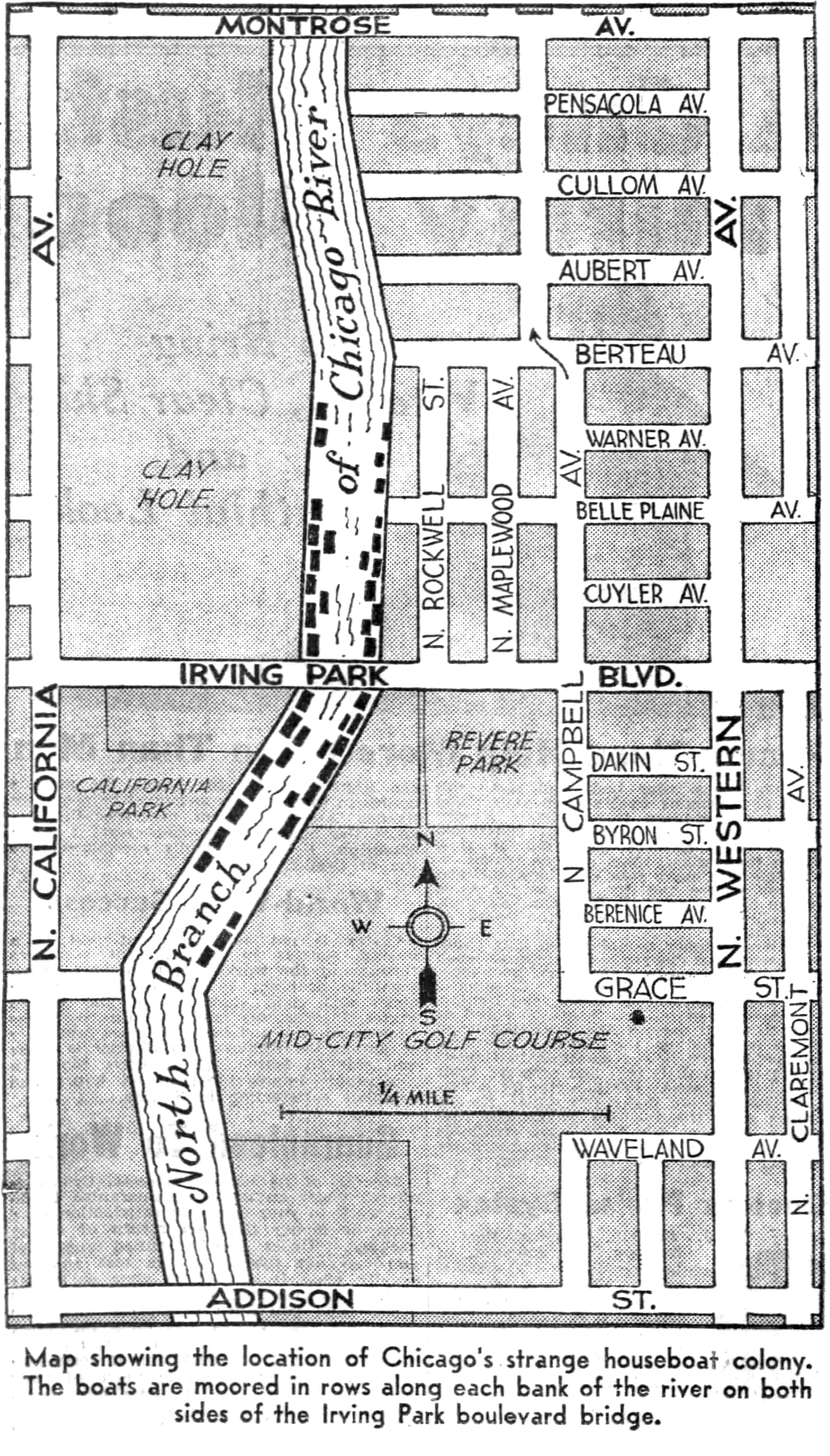
We go out north and west to Irving Park boulevard. Reaching the bridge across the north branch of the river, we turn up in a side street and park our car in front iof a boatyard. The river banks are high here and we don’t yet see the river cabins.
Following the boatyard fence to the river bank, we come to a footpath. Below us in the water are strung along bothe sides of the river and on both south and north sides of the Irving Park boulevard bridge. It is a cold day. Smoke rises from all of the tin chimneys.
We are on the east bank of the river. Wooden stairways lead down the side of the bank to each of the boats nelow us. Most of these are oblong cabins. They are about thirty feet long and twelve feet wide. We stand watching for a while, hoping to see some of the inhabitants moving about. None appears. Waliking down one of the narrow stairways, we cross a gangplank to the narrow end porch of one of the cabins. A knock on the door brings no immediate response. We knock again. Finally, after two or three minutes, the door is opened about an inch. An elderly woman is standing behind it. >
“What do you want?” she asks.
“We would like to know something about your houseboat community. Are you comfortable here?”
“I don’t talk to strangers.” The door slams shut.
At the next cabin our knock is answered quickly. This time the door is opened wide by another elderly woman. She tells us her home is comfortable. She has no children. She and her husband are on relief at present, but her husband hopes to get work at the boatyard in the spring.
“How do you get your water?”
“We carry it from the boatyard.”
“Do any of the people here have pipes to the city mains?”
“Yes, one or two of them do.”
She tells us the people on the houseboats have permission from the city to live on the river.
“Do they pay taxes?”
“I don’t know about that.”
We thank ger for the information and leave her boat. The next one in line is an old motor boat. It is half sunk and one end is fast in the mud of the bank. There is a tin chimney on the roof of the tiny cabin, but no smoke is visible from it. Apparently no one lives here, or, if so, the occupant is not at home. We peer into the window of the cabin.
It’s pretty dark in there, but wse can see the outline of a bunk and a round coal stove. It looks as if there is hardly room in this boat for one person to turn around in comfortably. Yet, someone lives here, all right. There are blankets on the bunk. On a shelf above it are cans of food. Apparently the man or woman who lives here is out for the day.
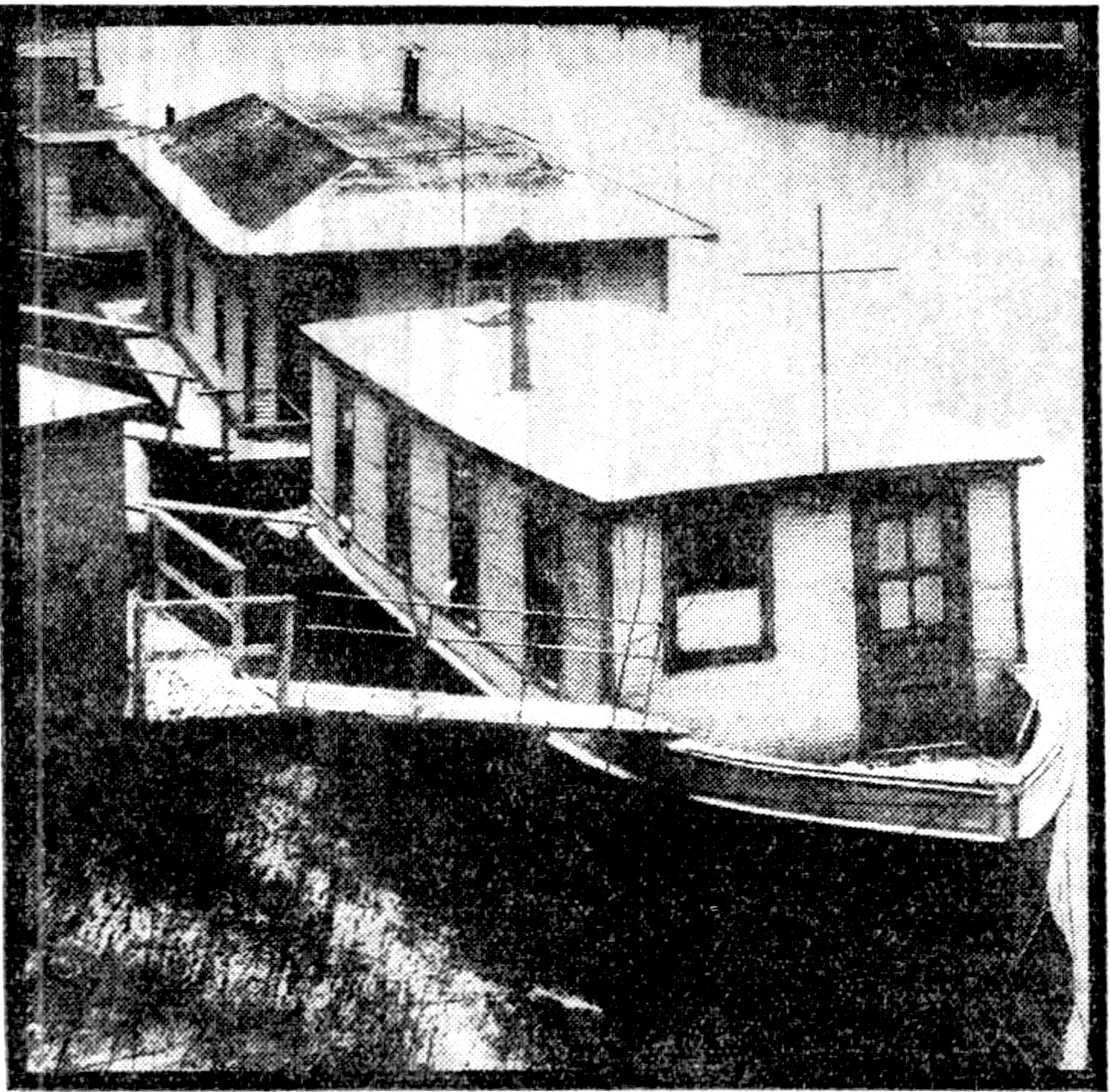
A close-up view if two of the cabins. The one in the foreground is well kept and is a plain but comfortable home. An elderly couple lives aboard.
The next boat in the line is one of the oblong cabins on a scow. It has a neater, cleaner apperance than some of the others. The gangplank is new and well made. The stairway up the side of the bank is wide and strong. We get the impression that here must live one of the aristocrats of Houseboat City.
Our knock is answered by a woman. She is about 45 years old. Her house dress is neat and clean. We tell her we are visiting the houseboat colony for the first time and that we would appreciate any information about the boats and the people she can giove us. Then gradually, as she answers our questions, she becomes more talkative.
“How do you like your neighbors?”
“O, about as well as other people like their neighbors, I guess.”
“Well, how do the people here on the river get along? Do you have a strong community spirit?”
“Yes, I’d say we have. There aren’t many of us, and we all live on boats. Most of the folks here are on relief right now. We have quite a lot in common.”
“Do the men try to fish in the river?”
“No. The water is too dirty and muddy for fish to live in. Anyway, I’ve never seen anyone fishing around here.”
“What do the houseboat people do for entertainment? Do you have community parties or gatherings of any kind?”
“O, we call on each other, and some of us have radios.”
“Do any of you ever move your boats to new locations in the river?”
“Hardly ever. O, sometimes in the spring or summer a new boat ties up, but most of these boats have been here for a long time. I don’t know of anyone who has an idea of moving. The boats that do are the smaller ones. Some of the motor boats travel back and forth in the summer, say to the lake and back, but they always come back here.”
Chicago Tribune, August 22, 1948

BY SALLY WATERBURY
Suppose you live in a houseboat on the north branch of the Chicago river. Your veranda is a deck, and your stair a gangplank. Sylvan scenery surrounds you in the midst of smokestacks and skyscrapers. Sunlight reflected from the water makes your ceilings bright by day, and moonlight changes the river to molten silver by night.
It sounds Arcadian, but there are aspects of the life that aren’t so delightful, houseboat owners admit. Plumbing problems, furniture that shifts as speedboats pass, the stench of chemicals in the water, and court fights to keep docking privileges must be reckoned with before one rushes to join the river dwellers.
Nevertheless inhabitants of nearly a dozen houseboats docked at Irving Park rd. and Diversey av. bridges are well satisfied with their floating homes. As Mrs.A. C. Henning, fishing boat captain’s widow, puts it, “Once you’ve lived on the water, you can never be free from its spell.”
Long Time Residents.
Altho many owners were driven to the river by the housing shortage, some, like Mrs. Henning, have lived on the water since the days when a showboat anchored at Diversey av. bridge every summer and more than 40 houseboats lined the river from North to Montrose avs.
“That was when my husband and I had a 112 foot houseboat tied at Randolph st.,” she reminisced. “I sold the fish brought in by the captain from Lake Michigan and often served fish dinners to his crew. In 1920 we moved the boat to Irving Park rd. bridge.”
Canary cages sway with the boat as a motor launch speeds by but when the river is still, the 45 foot boat’s movement is barely perceptible. Cables keep the vessel from swinging, and pipe braces hold it far enough from shore to float.
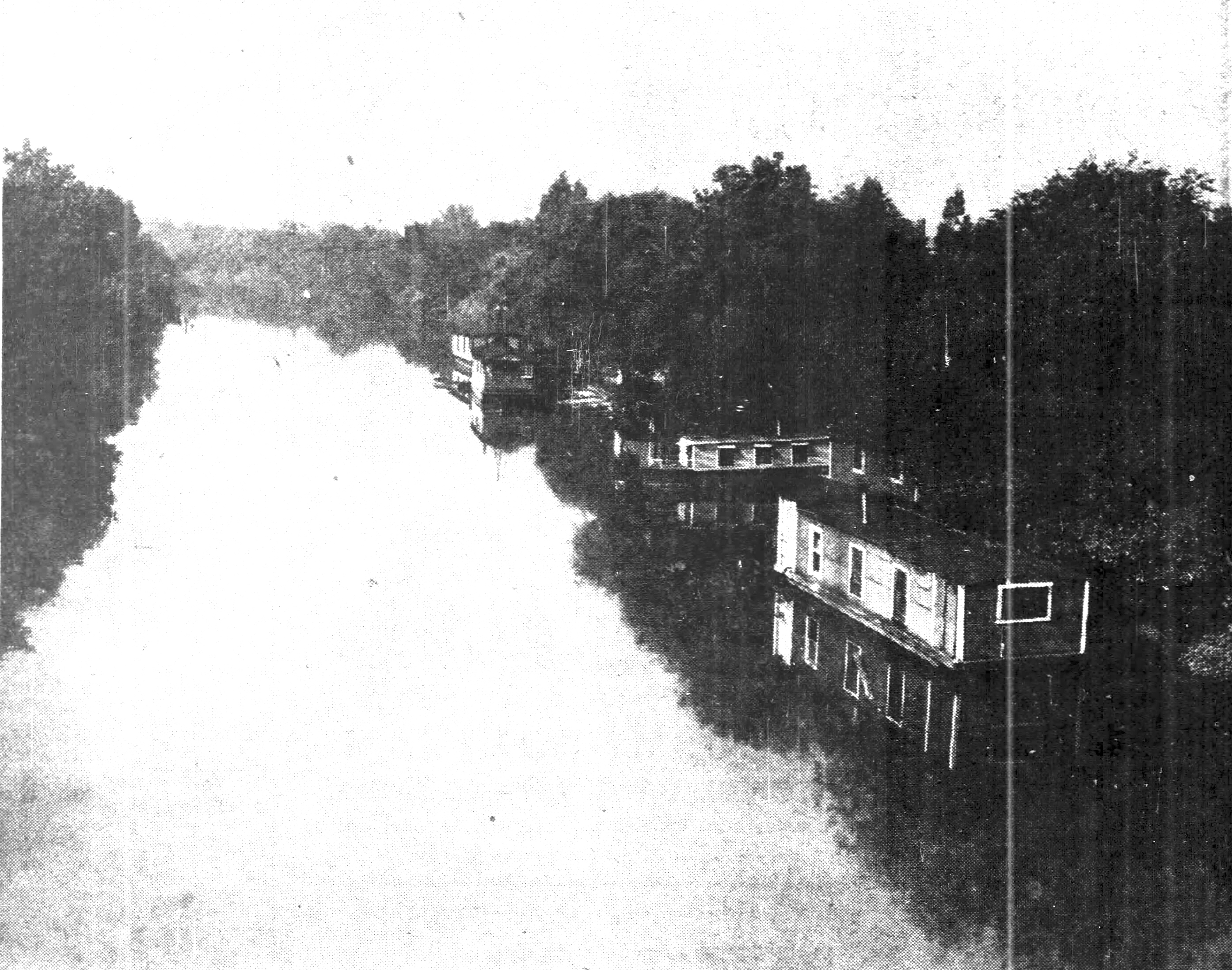
Chicago’s amphibious dwellers, survivors of a vanishing race, are changing type from men who makes a living on the water to those who can find no other place to live. The houseboats of old river men clustered south of Irving Park rd. bridge present a sylvan scene to passing motorists. Housing shortage victims colonize at other points along the north branch of the Chicago river, taking to the tax free homesteads with enthusiasm.
Heat With Oil Stove.
Mrs. Henning, who moved her present home to Irving Park rd. bridge after four years at Diversey av., heats her five rooms and bath with an oil stove. The boat is 20 feet wide with ceilings 8-1/2 feet high.
The widow placed electric wires from the shore when maintenance men showed her how. She has running water in kitchen and bathroom. Like many homemakers, her house is her hobby. She paints the outside with the help of a raft, and fills flower boxes with geraniums to brighten the entrance. A near-by vegetable plot started as a victory garden and a flower bed on the bank take much of her time. Most of the flowers were washed away, however, by a recent flood which raised the boat and gangplank high above the usual level.
Motorman 20 Years.
A neighbor who also makes a hobby of his houseboat is M. C. Simmons, a street car motorman for 20 years. His boat is at the north end of a row of four at Irving Park rd. Simmons joined the riverboat community with his wife in September, 1945, when, unable to find an apartment, he visited the boat of another motorman and decided to buy his own.
The motorman has spent three summers improving his boat. An electric cook stove and an oil heater have been installed in the vessel, divided into three large rooms and a bath. Simmons intends to paint the exterior this summer.
There was a time when all the floating homes at the bridge except Mrs. Henning’s were occupied by motormen, Simmons recalled. David Stenbrow, first motorman to tie up at Irving Park rd., still owns one of the four boats there, but his sister, Miss Dagney Stenbrow, lives in it today.
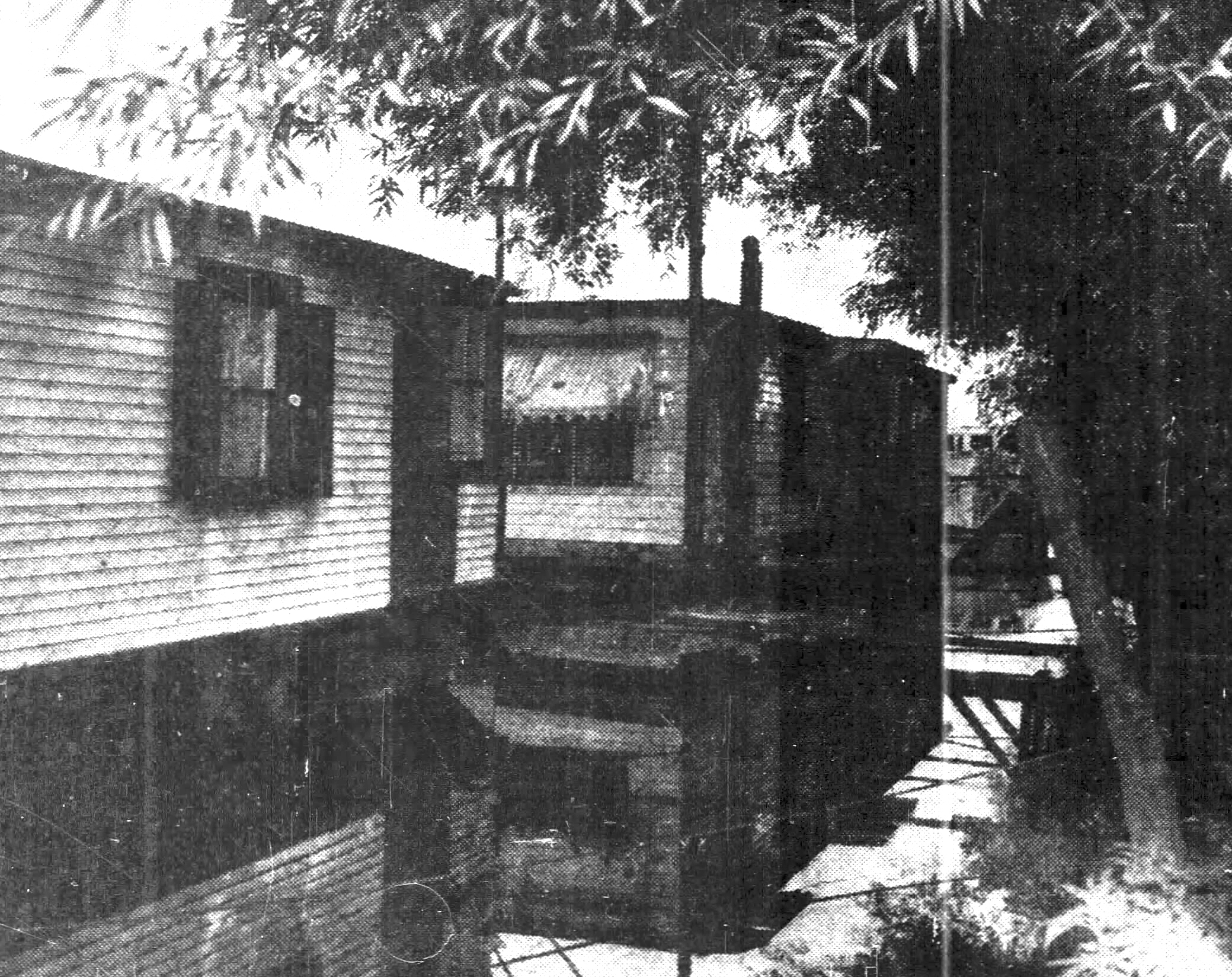
Rafts are used by residents in painting and repairing exteriors at Irving Park rd. bridge. Cables keep the boats from swinging, and braces hold them at the proper distance from shore. When the water rises, the boats and gangplanks rise too.
Few Children On Boats.
Mr. and Mrs. Henry Herr, victims of the housing shortage, recently bought the fourth houseboat from a former captain. None of the families have small children, since parents are too concerned about the river’s danger to join the community.
South of Irving Park rd. bridge a group of weather-beaten houseboats nestled among the foliage of the west bank form a picturesque scene. A few boats, homes of old rivermen, are pulled on shore while others float freely in the river. “Beware of Dog” signs warn that the old timers, who scrape rusty shovels on their decks, and whittle, do not wish to be disturbed.
A houseboat at Diversey av. bridge became a haven for Mr. and Mrs. Claude Sonday a year ago when they couldn’t find an apartment. Sonday, a mechanic, and instructor at Chicago Vocational High School, is so enthusiastic about the mode of living he has rigged a motor to propel the houseboat, and plans to travel down the Mississippi river in it someday.
He ands his wife, Lorraine, consider the need to carry water their greatest inconvenience. Altho the builder from whom they bought the boat had installed plumbing, pipes have not been attached. A small generator provides electricity, but Mrs. Sonday uses gas for cooking and ironimg.
Furniture Is Fixed.
Furniture is a houseboat can’t be moved at will, Mrs. Sonday points out. A dresser and table must balance a heavy bed or the boat will list. Slanting floors, hazards in cake baking and frying, are useful in that one knows where to look for rolling objects that are dropped. The Sondays have no basement to flood when the river rises, but their stone steps wash away. The river is kept from freezing in winter by industrial chemicals poured into it. An oil heater warms the floating home.
Married two years in October, the Sondays have many hobbies, including hunting, fishing, midget car racing, and their 10 month old son, Claude Jr. His mother asserts the blond, blue-eyed youngster is as safe in his playpen as in any apartment dwelling child. The water reflected sunlight charms the baby, and the boat’s motion rocks him to sleep.
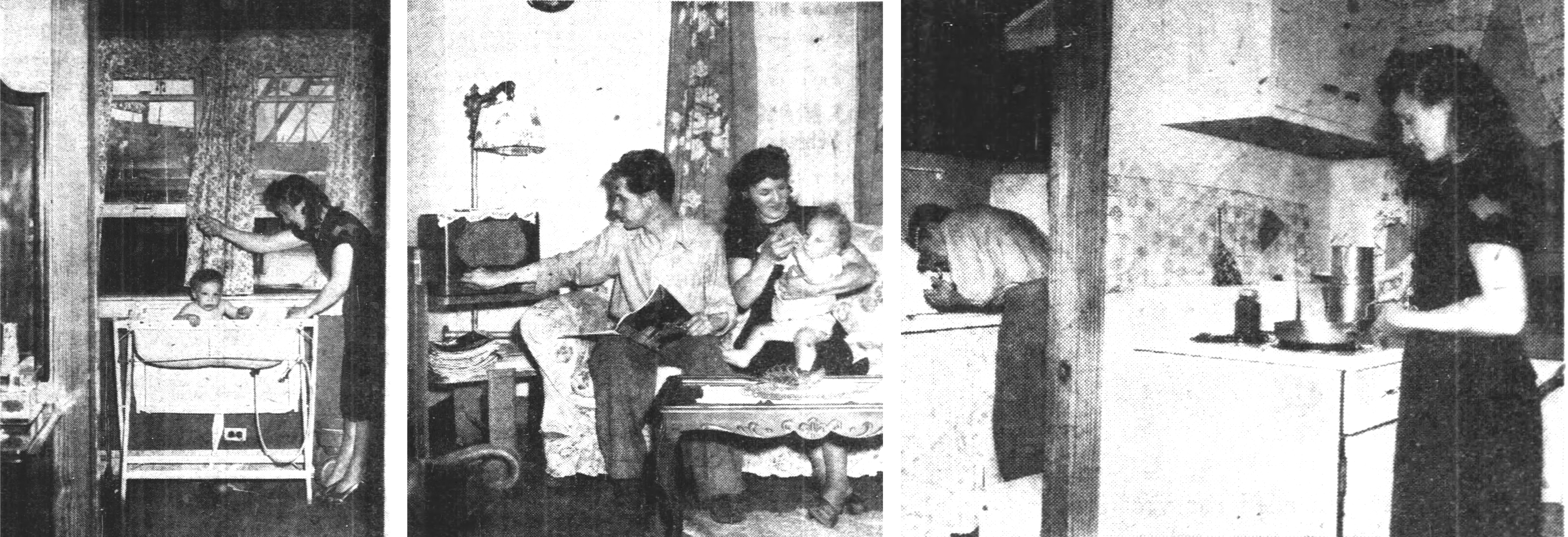
LEFT: Mrs. Claude Sonday cools Claude Jr., 10 months, with a shower in his nursery at the front of the Sondays’ houseboat overlooking Diversey st. bridge. The boat is a cradle for the child, his mother says, and the lapping of the water is a lullaby.
MIDDLE: Claude Sonday, mechanic and racing car driver, spends an evening with his family in the living room of the houseboat in which he has installed electricity, an oil heater run on an automobile fuel pump, and a propelling motor.
RIGHT: Claude Sonday washes for the dinner his wife, Lorrain, prepares in the tiny houseboat kitchen. Because the boat slants, grease in the frying pan collects on one side and food must be tended for even cooking.
Thank you for posting this interesting article. When I was 7 or 8 years old I remember visiting my father who was living on one of the houseboats moored just north of the Irving Park Rd. bridge. It was the early 60’s. I seem to remember the outside was painted blue and the inside was clean and cozy. He even had a small Hammond organ.
Thanks for the pictures of Claude and Lorraine Sonday. I am the fifth child, and Claude Jr. is my older brother.